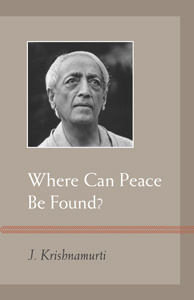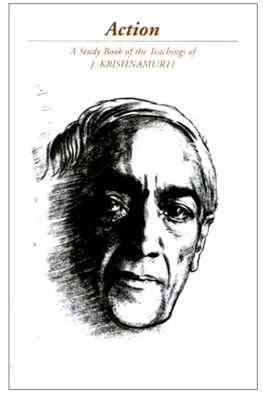Krishnamurti - A Timeless Spring: Krishnamurti at Rajghat
Here you can read online Krishnamurti - A Timeless Spring: Krishnamurti at Rajghat full text of the book (entire story) in english for free. Download pdf and epub, get meaning, cover and reviews about this ebook. publisher: Krishnamurti Foundation India, genre: Religion. Description of the work, (preface) as well as reviews are available. Best literature library LitArk.com created for fans of good reading and offers a wide selection of genres:
Romance novel
Science fiction
Adventure
Detective
Science
History
Home and family
Prose
Art
Politics
Computer
Non-fiction
Religion
Business
Children
Humor
Choose a favorite category and find really read worthwhile books. Enjoy immersion in the world of imagination, feel the emotions of the characters or learn something new for yourself, make an fascinating discovery.

- Book:A Timeless Spring: Krishnamurti at Rajghat
- Author:
- Publisher:Krishnamurti Foundation India
- Genre:
- Rating:3 / 5
- Favourites:Add to favourites
- Your mark:
- 60
- 1
- 2
- 3
- 4
- 5
A Timeless Spring: Krishnamurti at Rajghat: summary, description and annotation
We offer to read an annotation, description, summary or preface (depends on what the author of the book "A Timeless Spring: Krishnamurti at Rajghat" wrote himself). If you haven't found the necessary information about the book — write in the comments, we will try to find it.
A Timeless Spring: Krishnamurti at Rajghat — read online for free the complete book (whole text) full work
Below is the text of the book, divided by pages. System saving the place of the last page read, allows you to conveniently read the book "A Timeless Spring: Krishnamurti at Rajghat" online for free, without having to search again every time where you left off. Put a bookmark, and you can go to the page where you finished reading at any time.
Font size:
Interval:
Bookmark:
A Timeless Spring: Krishnamurti at Rajghat
Copyright 1993 Krishnamurti Foundation of America
& Krishnamurti Foundation Trust Ltd.
A Timeless Spring
Krishnamurti at Rajghat
Contents
Foreword
During his long and peripatetic life, J. Krishnamurti spent more than fifty winters in India, dividing his time between the large cities of Madras, Bombay and Delhi and his schools in Rajghat and Rishi Valley. A Timeless SpringKrishnamurti at Rajghat is the first of a series of books intended to evoke the flavour of Krishnamurtis presence in the places in India to which he returned year after year. These books will provide a record of Krishnamurtis teachings in a specific locus, and highlight the universal as well as the particular aspects of these Teachings.
Rajghat is situated on the outskirts of the city of Varanasi, on the banks of the Ganga. Rajghats classical past, its philosophical and religious traditions, its extreme conservatism, the beauty of its countryside and the poverty of its rural population, form the background against which Krishnamurti spoketo students, teachers, and to the public at large. Rajghat also provides the setting for several of Krishnamurtis reflections in his diaries and notebooks, selections from which are included here.
The selections in this book, taken largely from Krishnamurtis unpublished work, cover the period from 1955 to 1985. Selections from his writings on Rajghat are included to communicate his feeling for the place. Following this are samples of his talks with students, which show the delicacy and sensitivity with which Krishnamurti was able to pose eternal questions about the meaning of life to young minds. They are followed by illustrative samples of questions children raised with him. Then there is a selection of his public talks and several discussions with teachers, scholars and friends which illuminate the nature of dialogue as a mode of communication. An underlying hope in putting together this book is that the spirit of the place to which Krishnamurti gave of himself so abundantly would come alive through its pages. An introduction provides a brief history of Rajghat and Krishnamurtis association with it.
Ahalya Chari
Radhika Herzberger

Rajghat, the last of the five tirthas or spiritual fords that lead the pilgrim to the sacred waters of the Ganga at Varanasi, lies outside the relatively modern heart of that city. Green, with open spaces in the centre where Krishnamurtis educational institutions are located and a river bank that today draws sannyasis, pilgrims, fishermen, wrestlers, musicians, weavers, students and tourists to its shore, this beautiful ghat has truly a timeless quality. Myth and history, the sacred and the profane, the past and the present, are telescoped here.
Much of Varanasis historical record still lies buried underneath the high plateau overlooking the confluence of the Ganga and the Varana that is Rajghat. Two archaeological excavations have uncovered the evidence of a flourishing city dating back to the 6th and 7th centuries B.C. described by the Buddhist texts: beads made of lapis lazuli and carnelian, toy carts and rattles, part of a city wall, coins. The city was a manufacturing centre then, famed for its textiles and its perfumes; it lay along the uttarpatha, the ancient trade route that connected Magadha in the east with Gandhara in the north-west. Even now, when the foundations for new buildings are to be laid at Rajghat, the spade occasionally will turn up a headless god or a smiling yaksi.
Myth places Rajghat outside the framework of time; it is Sivas place, never forsaken by him. Even during pralaya, when all of creation is swallowed by the rising waters, Siva holds this piece of land on the tips of his trident, high above the flood waters. The ancient temple of Adikesava at Rajghat is a symbol of the gods eternal covenant with the place.
Myth and history coalesce on the pilgrims paths and in the ashramas. The ancient Panchakrosi path extends today beyond the village Kapiladhara to connect Rajghat with Sarnath, where the Buddha delivered his first sermon. Buddhist texts describe the Buddha fording the bridge across the Varana at Rajghat, before giving his first sermon. There are numerous temples, small shrines and ashramas that attest to the many religious figures who left behind some token of their historical associations with Kasi.
Krishnamurtis first visit to Varanasi dates back to 1910, when he and his brother Nityananda accompanied Dr Annie Besant to the Theosophical Lodge. He was fifteen then, and Dr Besant was a powerful figure. Equipped with an ideology that saw in the Theosophical movement and in the boy Krishnamurti a way of regenerating Indias spiritual past, identified with the movement to free India from colonial rule, a great orator and a woman of enormous energy, Dr Besant was friends with the leading citizens of Varanasi, including the famous scholar Gopinath Kaviraj and Dr Bhagavan Das.
Dr Besant saw her role in Krishnamurtis life as that of a catalyst: Amma never told me what to do Krishnamurti gratefully recalled in later life. She merely tried to put him in touch with the best of what was available in the world and, so, Krishnamurti visited Varanasi frequently and was encouraged by Dr Besant to meet people, to talk and eventually to lead the spiritual discussions that were part of the Societys annual programme. She also set up a separate organization within the Theosophical Society, the Order of the Star, dedicating it to Krishnamurtis work.
In 1928 Krishnamurti was inspired by the great university at Berkeley to set up educational institutions in his own right. In looking for land, from the very beginning, Krishnamurti seemed to know what he wanted: Four hundred acres of land on the banks of the river at Banaras (Varanasi). After locating a hundred-and-fifty acres of land on the banks of the Ganga which belonged to the British Military Cantonment Board, with single-minded devotion and tenacity he managed to persuade the authorities to sell the land. Money was found and, then, in due course, Sanjiva Rao negotiated the purchase of the two-hundred-and-twenty-five acres that lies across the Varana, near the village of Sarai Mohana.
Between 1928 and 1948, Sanjiva Rao built a coeducational, residential school at Rajghat, calling it the Rajghat Besant School. Later, the Vasanta College for women students, and Vasantashrama, a womens dormitory, were located here.
When Krishnamurti returned to Varanasi in 1948 after an extended absence, he stayed at Rajghat in a house overlooking the Ganga. And during the next thirty-eight years he returned to this house again and again, talking to students, scholars, and visitors from all over the world.
The Ganga rises in the Himalayas and flows across the great plains of North India into the Bay of Bengal. Except along one stretch lying between the ghats of Varanasi where the river suddenly turns and flows northward towards its source, it follows a south-easterly course. For the ancient geographers, the river turned back on itself, like the meditating mind of the sage, was symbolic of the rivers sacredness.
In Krishnamurtis writing, the river Ganga as an image for the meditating mind is a recurrent metaphor. Writing at Rajghat in his Notebook, he says: Meditation was like that river, only it had no beginning and no ending; it began and its ending was its beginning.
The metaphor is carried forward, for the life-giving waters of the Ganga share with the meditating mind the power to end:
The river curves majestically as it flows east past the villages, town and deep woods, but here, just below the town and the bridge, the river and its opposite bank is the essence of all river banks; every river has its own song, its own delight and mischief, but here, out of the very silence, it contains the earth and the heavens. It is a sacred river, as all rivers are, but again here, a part of the long, winding river, there is a gentleness of immense depth and destruction.
Font size:
Interval:
Bookmark:
Similar books «A Timeless Spring: Krishnamurti at Rajghat»
Look at similar books to A Timeless Spring: Krishnamurti at Rajghat. We have selected literature similar in name and meaning in the hope of providing readers with more options to find new, interesting, not yet read works.
Discussion, reviews of the book A Timeless Spring: Krishnamurti at Rajghat and just readers' own opinions. Leave your comments, write what you think about the work, its meaning or the main characters. Specify what exactly you liked and what you didn't like, and why you think so.







